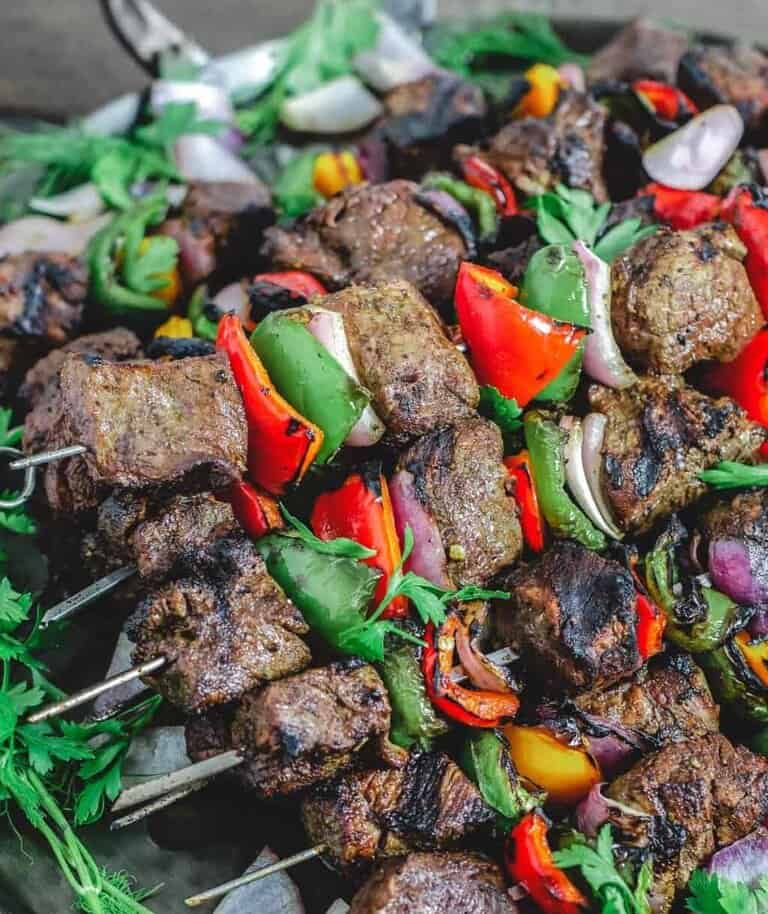Kebabs have exploded in popularity, and while what exactly a kebab is will vary from place to place depending on the local food sources, culture, and traditional methods of preparation, there are certain common features most kebabs have. After all, most kebabs fall under one of three styles, and all the variations of those still are made the same way. If you’ve seen one – you’re familiar with the other takes. One common question that comes up: do kebabs have bones?
Kebab meat is prepared in a way that means there are no bones. The only kebabs that might have bones are fish kebabs, as fish that hasn’t been fully or properly de-boned might have one or two small bones.
Understandably anyone looking to enjoy a delicious kebab for the first time wants to know if there are any food or dietary concerns. Fortunately, the overwhelming majority of time you won’t have to worry about bones at all. Let’s dive into how kebabs are made, why you can be sure bones won’t be a problem, what nutritional issues and allergy concerns you should watch out for, then read on.

Why Don’t Kebabs Have Bones?
This is all about preparation. These aren’t soups or cuts of fowl or stews, but a kebab tends to be cut from sausage, a mixture of meat and spices pressed together with a bonding agent on a skewer, or slices of meat interspersed with vegetables and mushrooms.
Because of the preparation, there’s just not any bones. This isn’t a soup that has meat wholesale tossed in, or have cuts of meat that tend to be tendon heavy or have small bones. While some animals like chicken have bones, and can have bones depending on the preparation, the cuts of meat from a chicken that would be used for kebabs like a shish kebab would be from cuts away from where any small bones or connecting tissue might be found.
This helps keep them bone free, which is wonderful because that’s one less thing to worry about.
Do Doner Kebabs Have Bones?
Doner kebabs should never have any bones in them. The conventional recipe for the popular Doner Kebab, which has becoming incredibly popular in both Europe and the United States, comes from a big ground sausage made from other meats that have been ground together and reconstituted into kebab sausage and is designed to then be shaved into a pita bread style of toppings and dressings.
When you’re shaving meat off a giant sausage, you don’t have to worry about bones which means that the Doner Kebab, unquestionably the most popular kebab style in many parts of Europe and the United States, is going to be bone-free as the base sausage should never have any bone or cartilage in it.
Do Shish Kebabs Have Bones?
Shish Kebabs are set up with a skewer system where pieces of lamb, chicken, or even beef are skewered along with vegetables and sometimes chilies or mushrooms. The meat should be cut clearly from bone, tendon, or other inedible pieces of meat which is why there should not be concerns with bones. There are two potential situations to be careful of.
One is if the place uses a substandard piece of chicken, in which case there is a very outside possibility that a very small piece of bone would have the ability to slip in. The other is with fish, which can have very thin bones that sometimes slip by even the knife of experienced anglers.
Do Other Kebabs Have Bones?
While possible, this all depends on the meat used and the traditional method of preparation. In most places where kebabs are common, the meat is skewered, meaning it is sliced off any potential bone before preparation. This prevents any potential issues with bones in the meat.
Because of that preparation, I’m not familiar with any kebab style that has bones in it. This isn’t to say that there might not be one that exists somewhere, but this is certainly going to be uncommon compared to the most popular styles of kebabs – none of which are going to have common problems with bones.
If someone mentions a kebab with bone in it, generally that means someone is taking the basic outline of a traditional kebab recipe or makeup of a kebab but then adding a piece of meat that is prepared separately like lamb on the bone or an in-bone pork chop (for all the heathens out there). Adding this to a pita bread with kebab dressing, onions, lettuce, and other conventional dressings.
There Are Food Worries With Kebabs…But Bones Aren’t Among Them!
There are some genuine concerns with kebabs, but running into bones isn’t a big one. Unless you are enjoying a fish kebab, and there are very few situations where a bone would get anywhere close to a kebab during preparation. Fish kebabs aren’t especially common, but they are the most likely way that a bone or two is likely to sneak in.
The most common worries with kebabs, especially those that are regional cuisine, include:
- Peanuts or peanut oil – or similar local nuts that could cause allergic reactions in some people
- Dairy in the kebab sauce, especially when dressing and lettuce OR yogurt is an ingredient
- Cross contamination from nuts or nut dust
- The high fat content and high calorie numbers with many kebab types
These are much more common potential issues that come with eating kebabs as opposed to bones and should be the top of your list of things to be wary of and to watch out for if any of them would cause concern.
Don’t let this scare you away from kebabs if you don’t have to worry about food allergies. There are many delicious types of kebabs and I strongly encourage you to enjoy the many culinary joys these have to offer!
Other Kebab Articles You May Love
